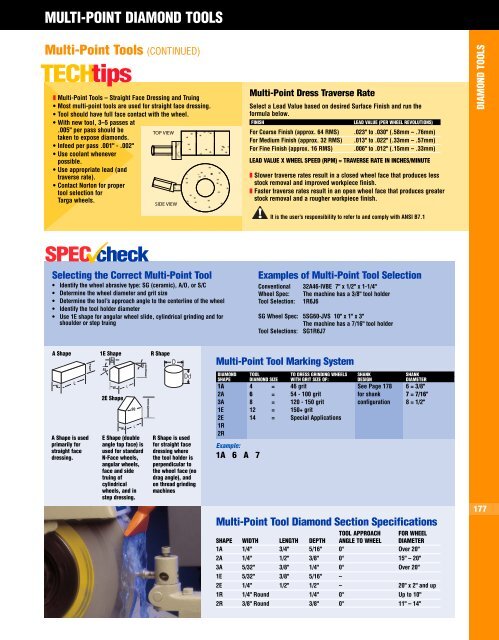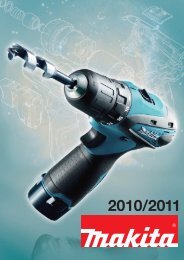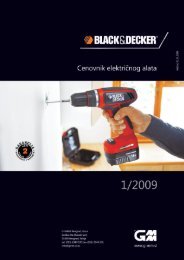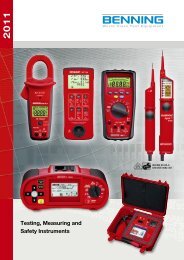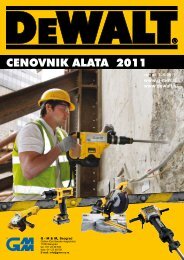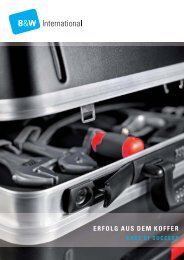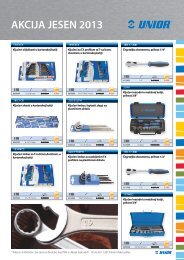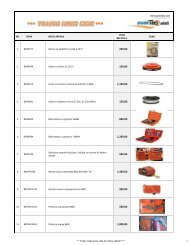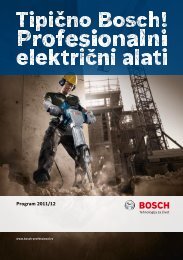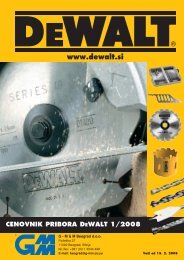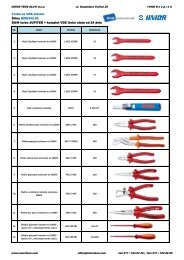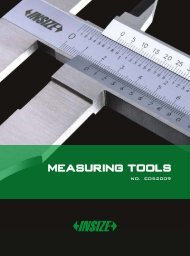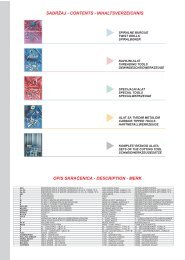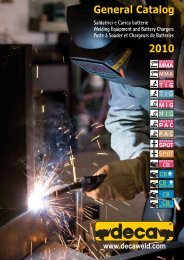Cut-off Wheels
Cut-off Wheels
Cut-off Wheels
Create successful ePaper yourself
Turn your PDF publications into a flip-book with our unique Google optimized e-Paper software.
MULTI-POINT DIAMOND TOOLS<br />
Multi-Point Tools (CONTINUED)<br />
TECHtips<br />
❚ Multi-Point Tools – Straight Face Dressing and Truing<br />
• Most multi-point tools are used for straight face dressing.<br />
• Tool should have full face contact with the wheel.<br />
• With new tool, 3–5 passes at<br />
.005" per pass should be<br />
TOP VIEW<br />
taken to expose diamonds.<br />
• Infeed per pass .001" - .002"<br />
• Use coolant whenever<br />
possible.<br />
• Use appropriate lead (and<br />
traverse rate).<br />
• Contact Norton for proper<br />
tool selection for<br />
Targa wheels.<br />
SIDE VIEW<br />
Multi-Point Dress Traverse Rate<br />
Select a Lead Value based on desired Surface Finish and run the<br />
formula below.<br />
FINISH<br />
LEAD VALUE (PER WHEEL REVOLUTIONS)<br />
For Coarse Finish (approx. 64 RMS) .023" to .030" (.58mm – .76mm)<br />
For Medium Finish (approx. 32 RMS) .013" to .022" (.33mm – .57mm)<br />
For Fine Finish (approx. 16 RMS) .006" to .012" (.15mm – .33mm)<br />
LEAD VALUE X WHEEL SPEED (RPM) = TRAVERSE RATE IN INCHES/MINUTE<br />
❚ Slower traverse rates result in a closed wheel face that produces less<br />
stock removal and improved workpiece finish.<br />
❚ Faster traverse rates result in an open wheel face that produces greater<br />
stock removal and a rougher workpiece finish.<br />
DIAMOND TOOLS<br />
It is the user’s responsibility to refer to and comply with ANSI B7.1<br />
SPEC check<br />
Selecting the Correct Multi-Point Tool<br />
• Identify the wheel abrasive type: SG (ceramic), A/O, or S/C<br />
• Determine the wheel diameter and grit size<br />
• Determine the tool’s approach angle to the centerline of the wheel<br />
• Identify the tool holder diameter<br />
• Use 1E shape for angular wheel slide, cylindrical grinding and for<br />
shoulder or step truing<br />
Examples of Multi-Point Tool Selection<br />
Conventional 32A46-IVBE 7" x 1/2" x 1-1/4"<br />
Wheel Spec: The machine has a 3/8" tool holder<br />
Tool Selection: 1R6J6<br />
SG Wheel Spec: 5SG60-JVS 10" x 1" x 3"<br />
The machine has a 7/16" tool holder<br />
Tool Selections: SG1R6J7<br />
A Shape<br />
W<br />
L<br />
A Shape is used<br />
primarily for<br />
straight face<br />
dressing.<br />
D<br />
1E Shape<br />
3"<br />
64 D<br />
45<br />
45<br />
D<br />
W<br />
2E Shape<br />
W<br />
E Shape (double<br />
angle top face) is<br />
used for standard<br />
N-Face wheels,<br />
angular wheels,<br />
face and side<br />
truing of<br />
cylindrical<br />
wheels, and in<br />
step dressing.<br />
L<br />
90<br />
L<br />
D<br />
R Shape<br />
Dd<br />
R Shape is used<br />
for straight face<br />
dressing where<br />
the tool holder is<br />
perpendicular to<br />
the wheel face (no<br />
drag angle), and<br />
on thread grinding<br />
machines<br />
Multi-Point Tool Marking System<br />
DIAMOND TOOL TO DRESS GRINDING WHEELS SHANK SHANK<br />
SHAPE DIAMOND SIZE WITH GRIT SIZE OF: DESIGN DIAMETER<br />
1A 4 = 46 grit See Page 178 6 = 3/8"<br />
2A 6 = 54 - 100 grit for shank 7 = 7/16"<br />
3A 8 = 120 - 150 grit configuration 8 = 1/2"<br />
1E 12 = 150+ grit<br />
2E 14 = Special Applications<br />
1R<br />
2R<br />
Example:<br />
1A 6 A 7<br />
Multi-Point Tool Diamond Section Specifications<br />
TOOL APPROACH FOR WHEEL<br />
SHAPE WIDTH LENGTH DEPTH ANGLE TO WHEEL DIAMETER<br />
1A 1/4" 3/4" 5/16" 0° Over 20"<br />
2A 1/4" 1/2" 3/8" 0° 15" – 20"<br />
3A 5/32" 3/8" 1/4" 0° Over 20"<br />
1E 5/32" 3/8" 5/16" –<br />
2E 1/4" 1/2" 1/2" – 20" x 2" and up<br />
1R 1/4" Round 1/4" 0° Up to 10"<br />
2R 3/8" Round 3/8" 0° 11" – 14"<br />
177


